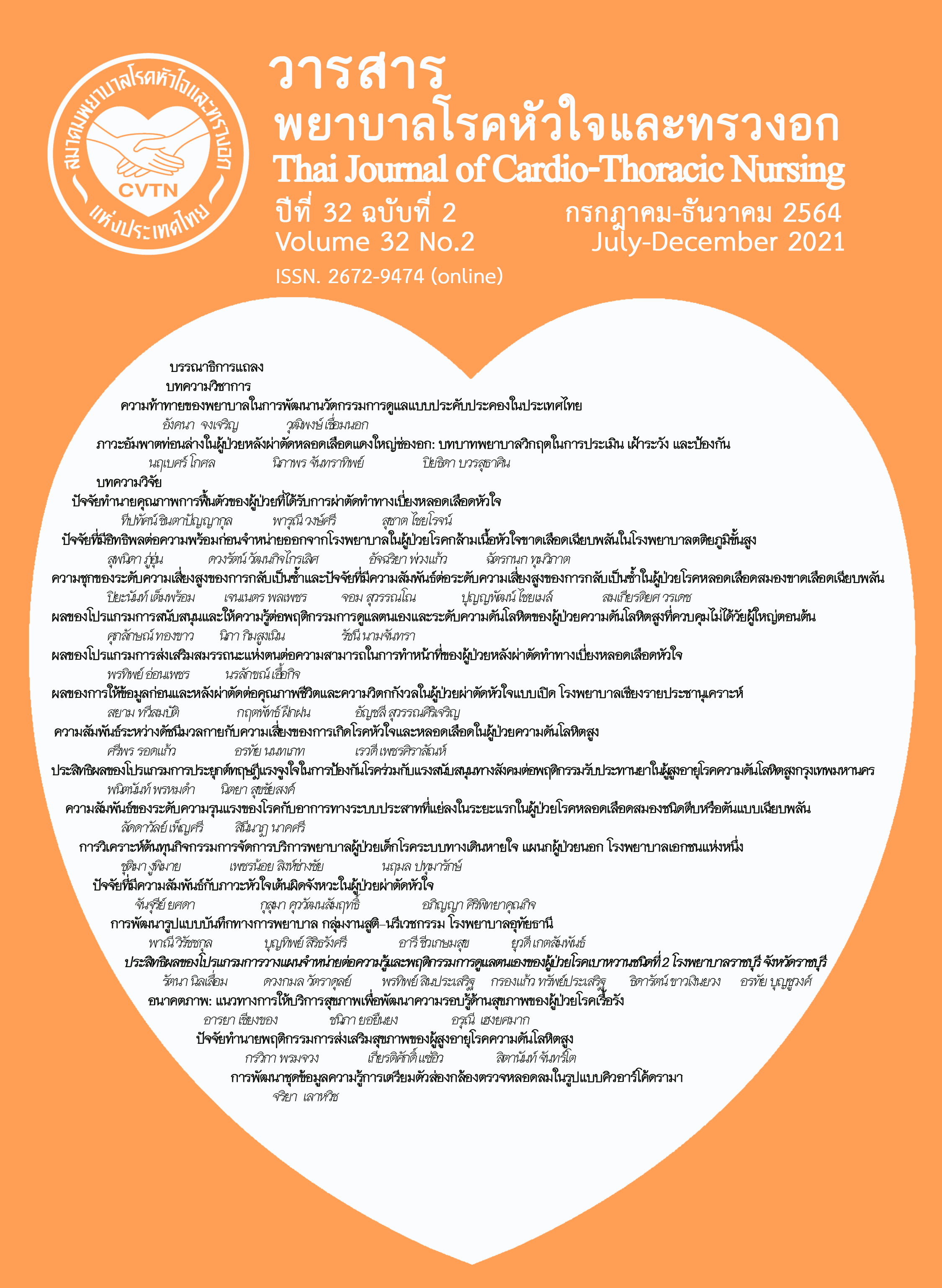Predictive factors in quality of recovery among patients after coronary artery bypass graft surgery
Keywords:
quality of recovery, cardiac surgery, coronary artery bypass graft surgeryAbstract
The purposes of this predictive research were to study quality of recovery and to examine the predictability of predicting factors. Data were collected from 116 patients with coronary artery bypass graft surgery were recruited from a purposive selection in the cardiac clinic at the Ramathibodi hospital. The research instruments were composed of demographic information, comorbidity, mood state, social support, and the postoperative recovery profile (PRP) questionnaire. Data were analyzed using descriptive and stepwise multiple regression statistics.
Findings indicated that the mean score of the quality of recovery in coronary artery bypass graft (CABG) surgery patients was almost complete recovery (Mean = 15.43, SD = 0.75). Social support and ejection fraction were positively related to quality of recovery in patients with CABG at the level of .05 (r = .632 and r = .600 respectively) and comorbidity, ages, and mood state were negatively related to quality of recovery in patients with CABG at the level of .05 (r = -.570, r = -.518, r = -.338 respectively). In addition, social support, comorbidity, ejection fraction, ages, and mood were good predictors with 64.6% of total variances explained for quality of recovery in patients with CABG.
The results can be used as a guide to nursing care for patients with coronary artery bypass graft by focusing on the involvement of family members and multidisciplinary medical teams to promote postoperative recovery of CABG more effectively and efficiently.
References
Benjamin EJ, Virani SS, Callaway CW, Chamberlain AM, Chang AR, Cheng S. et al. Heart disease and stroke statistics-2018 update a report from the American Heart Association. Circulation. 2018;137:e67–e492.
Bureau of Policy and Strategy, Ministry of Public Health. Public health statistics B.E. 2017. Bangkok: The war veterans affairs office printing; 2018.
Hardin SR, Kaplow R. Cardiac surgery essentials for critical care nursing (2nd edition). Sudbury, MA: Jones and Bartlett Publishers; 2016.
Chaiyaroj S. Coronary artery bypass surgery: CABG. In: Chaiyaroj S, editor. Essentials in cardiothoracic surgery. Bangkok: Idea instant printing; 2010. (in Thai).
Chintapanyakun T, Ua-Kit N, Chaiyaroj S. Predicting factors of health status among patients after coronary artery bypass graft surgery. Thai Journal of Cardio-Thoracic Nursing. 2017;28(1); 96-110. (in Thai).
Abu-Omar Y & Taggart DP. Coronary artery bypass surgery. Medicine. 2014;42(9): 527-31.
Bratt A, Allvin R, Wann-Hansson C. Modifying a generic postoperative recovery profile instrument to an instrument specifically targeting coronary artery bypass grafting. Scand J Caring Sci. 2017;31(3):475-86.
Allvin R, Berg K, Idvall E, Nilsson U. Postoperative recovery: A concept analysis. J Adv Nurs. 2007;57(5), 552-58.
Allvin R, Ehnfors M, Rawal N, Svensson E, Idvall E. (2009). Development of a questionnaire to measure patient-reported postoperative recovery: Content validity and intra-patient reliability. J Eval Clin Pract. 2009; 15(3): 411–19.
Parker RD, Adams J. Activity restrictions and recovery after open chest surgery: understanding the patient's perspective. Proc (Bayl Univ Med Cent). 2008;21(4):421-5.
Urtritaprasit K. The relationship between recovery symptom and functional outcome in Thai CABG patients. [Dissertation Doctor of Philosophy]. Ohaio: Case Western Reserve University; 2001.
Utriyaprasit K, Moore S. Recovery symptoms and mood states in Thai CABG patients. J Transcult Nurs. 2005;16(2): 97-106.
Hawkes AL, Nowak M, Bidstrup B, Speare R. Outcome of coronary artery bypass graft surgery. Vasc Health Risk Manag. 2006; 2(4): 477-84.
Jitardhan K, Kobkitsumongkol K, Uaaree P, Sangmanee S, Sanjaroensuttikul N. Factors relating to the return to work of the patients post open heart surgery. Journal of Rehabilitation Medicine. 2011;21(2): 43-9. (in Thai).
Neupane I, Arora RC, Rudolph JL. Cardiac surgery as a stressor and the response of the vulnerable older adult. Exp Gerontol. 2017;87:168-74.
Charokopos N, Antonitsis P, Toumbouras M, Konstantinopoulos J, Rouska E. Influence of Fast-Track Recovery after Coronary Artery Bypass in the Elderly. Asian Cardiovasc Thorac Ann. 2007;15(2):144-148.
Nakon O. Factors associated with recovery of diabetic ischemic heart patients following coronary artery bypass grafting. [Master Thesis of Nursing Science]. Bangkok: Mahidol University; 2010. (in Thai).
Nagendran J, Norris CM, Appoo JJ, Ross DB, Nagendran J. Left ventricular end-diastolic pressure predicts survival in coronary artery bypass graft surgery patients. Ann Thorac Surg. 2014;97(4):1343-7.
Barnason S, Zimmerman L, Nieveen J, Schulz P, Young L. Patient recovery and transitions after hospitalization for acute cardiac events: An integrative review. J Cardiovasc Nurs. 2012;27(2):175-91.
Jiaepoemsuk P., Ua-kit N. Selected factors associated with recovery among post coronary artery bypass graft patient. Royal Thai Navy Medical Journal. 2018;45(1): 66-84. (in Thai).
Lopez V, Sek Ying C, Poon CY, Wai Y. Physical, psychological and social recovery patterns after coronary artery bypass graft surgery: A prospective repeated measures questionnaire survey. Int J Nurs Stud. 2007;44(8):1304-15.
Utriyaprasit K, Moore SM, Chaiseri P. Recovery after coronary artery bypass surgery: effect of an audiotape information programme. J Adv Nurs. 2010;66(8):1747-59.
Charlson ME, Pompei P, Ales KL, Mackenzie CR. A new method of classifying prognostic co-morbidity in longitudinal studies: Development and validation. J Chronic Dis. 1987; 40(5): 373-83.
Leelacharas S. Illness representations in Thai women diagnosed with hypertension and relationships to medication-taking behavior. [dissertation]. Ann Arbor (MI): University of Michigan; 2005.
House JS. Work, stress, and social support. Reading, MA: Addison-Wesley; 1981.
Howell DC. Statistical methods for psychology (8th edition) Belmont, California: Wadsworth Cengage Learning; 2013.
Keeling WB, Williams ML, Slaughter MS, Zhao Y, Puskas JD. Off-pump and on-pump coronary revascularization in patients with low ejection fraction: A report from the society of thoracic surgeons national database. Ann Thorac Surg. 2013;96(1):83-8.
Wongsri, P. Chintapanyakun, T. Utilization of Orem’s theory with caring and advice for patients with heart failure. Journal of The Police Nurses. 2018;10(1): 209-19. (in Thai).
Williams PA. Basic geriatric nursing (7th Edition). Elsevier: John Wiley & Sons; 2016.
Natarajan A, Samadian S, Clark S. Coronary artery bypass surgery in elderly people. Postgrad Med J. 2007;83(977):154-8.
Downloads
Published
How to Cite
Issue
Section
License
Copyright (c) 2022 Thai Journal of Cardio-Thoracic Nursing

This work is licensed under a Creative Commons Attribution-NonCommercial-NoDerivatives 4.0 International License.
บทความนี้ยังไม่เคยตีพิมพ์หรืออยู่ในระหว่างส่งไปตีพิมพ์ในวารสารอื่น ๆ มาก่อน และกองบรรณาธิการขอสงวนสิทธิ์ในการตรวจทาน และแก้ไขต้นฉบับตามเกณฑ์ของวารสาร ในกรณีที่เรื่องของท่านได้ได้รับการตีพิมพ์ในวารสารฉบับนี้ถือว่าเป็น ลิขสิทธิ์ของวารสารพยาบาลโรคหัวใจและทรวงอก






